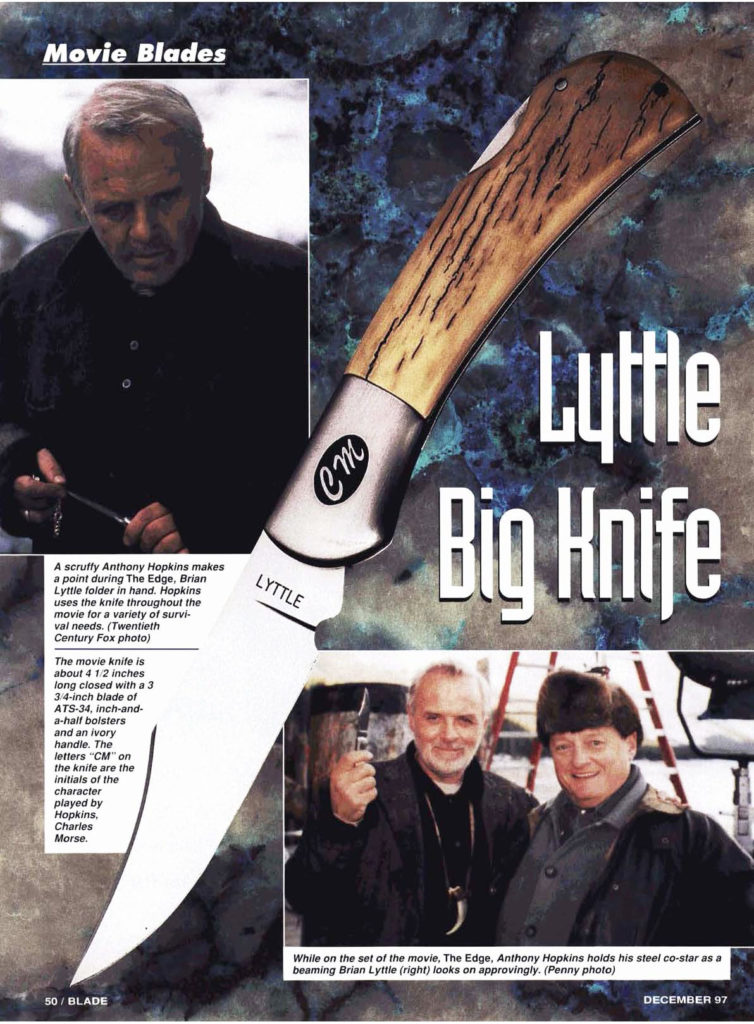
Editor’s note: The following originally appeared in the December 1997 issue of BLADE. Find more from BLADE‘s extensive archive in this download.
Brian Lyttle’s Blade Get Top Billing in Survival Epic, The Edge
Meanwhile, The Edge, starring award-winning actor Anthony Hopkins as a man trying to survive in harsh environs with the help of his knife and his ingenuity, may be a movie worth watching not only for the way he employs his blade but because it’s just fine entertainment.
One thing’s certain: Canadian knifemaker Brian Lyttle will be much more than just an interested observer because he made the “steel star” of the film and even appears in the flick as an extra.
The Design
The knife is a large folding hunter designed for the applications to which Hopkins puts it in the movie.
“It’s a gentleman’s piece in an old-time style but large enough for use as a tool to make traps and spears and for other survival needs,” Lyttle (pronounced LITTLE) observed. According to the maker, a voting member of The Knifemakers’ Guild who specializes in highly embellished folders and straight blades, film officials inspected similar knife patterns by assorted U.S. manufacturers to arrive at the piece they wanted.
“They liked big folders with clip-point blades,” he noted.
The result is a knife about 4 1/2 inches long closed with a 3 3/4-inch blade, inch-and-a-half bolsters and an ivory handle. Though Brian specializes in damascus, he used ATS-34 for the blade because movie officials said they wanted a material that wouldn’t stain. The letters “CM” on the knife are the initials of the character played by Hopkins, Charles Morse.
Multiple Models
Lyttle did five knives in all for the movie-four lockbacks and one sliplock. Of the four lockbacks, one is sharp for scenes where cutting is required; one’s dull for scenes where the prevention of any “accidental cutting” is the main concern; one’s a standby; and one’s the presentation piece used in the film. The sliplock appears in an underwater scene where the knife is used to cut a seat belt.
“They didn’t want the performer to have to worry about unlocking the blade while underwater,” Lyttle explained the reason for the sliplock.
He sold four of the knives to movie officials and rented the fifth one to them so he could get it back after filming.
The Knifemaker Steps Into the Movie
Don’t look for Lyttle’s name in the credits at the end of the movie. However, do look for a reference to the maker during the scene where the knife is presented to Hopkins. Inside the blade’s presentation box is a certificate that says, “Lyttle Knife Co.” By the way, that’s the blade Brian rented to the movie and is the one photographed with this story.
Knives are not the only examples of Brian’s work in the film. A skilled engraver, he engraved two watches (a gold one for Hopkins and a stainless steel Omega for co-star Alec Baldwin) and the presentation knife that appears early in the flick.
“The engraving will be easily visible and there’s a special reason for it to be seen,” he winked. “I read the script and it looks like one helluva movie. Hopkins doesn’t do duds.”
A Connection Through Brad Pitt and Legends of the Fall
How did the movie officials learn of Lyttle and his knifemaking? During the filming of Legends Of The Fall, an earlier flick also done in the High River area starring Hopkins and Brad Pitt, Lyttle’s work came to the attention of Pitt.
Pitt visited Lyttle’s home and bought some knives and gave them to some of the movie’s cast, including Hopkins. The same man who put Lyttle in touch with Pitt introduced Brian to an assistant props master.
When it came time to select the knives for The Edge, the assistant props master brought along Lyttle’s knives during a meeting of movie officials, a meeting attended by Hopkins. When Hopkins saw the blades he recognized the maker’s name on them.
Hopkins reportedly said, “They’re damn sharp!”
His reaction no doubt helped sway the movie officials’ decision and Brian had almost every knifemaker’s dream job: making movie blades.
“A Pain in the Neck”
As with most movie relationships, however, it was no picnic for Lyttle. He had to work long hours to get the pieces ready.
“I had three weeks to get the first knife done and I had a knife show to do in-between,” he recalled. “I had to work day and night to meet their deadlines. I had two days off one month and worked some days through midnight until four in the morning.”
And, of course, the movie officials could be a pain in the neck.
“They were very fussy over stuff,” Brian related. “Twelve presentation boxes (for the knife presentation scene) had to be made before they were satisfied with one.”
Worth the Trouble
Still, as almost any knifemaker will tell you, all the toil and trouble is worth it for the dividends such exposure does not only now but down the road, and specifically for Lyttle when people will come up to his table at a knife show and say, “Wasn’t that your knife in that movie with Anthony Hopkins?”
BLADE’s annual Knife Guide Issue features the newest knives and sharpeners, plus knife and axe reviews, knife sheaths, kit knives and a Knife Industry Directory.Get your FREE digital PDF instant download of the annual Knife Guide. No, really! We will email it to you right now when you subscribe to the BLADE email newsletter.
Click Here to Subscribe and get your free digital 2024 Knife Guide!